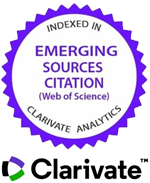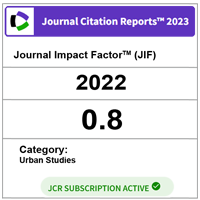Mapping and Estimation of Above-ground Grass Biomass using Sentinel 2A Satellite Data
DOI:
https://doi.org/10.11113/ijbes.v8.n3.684Keywords:
Grass, Biomass Estimation, Mapping, Satellite DataAbstract
Above-Ground Grass Biomass (AGGB) mapping and estimation is one of the important parameters for environmental ecosystem and grazing-lands management, particularly for livestock farming. However, previous models for estimation of AGGB with satellite imagery has some difficulty in choosing a particular satellite and vegetation index that can build a good estimation model at a higher accuracy. This study explores the potentiality of Sentinel 2A data to derive a satellite-based model for AGGB mapping and estimation. The study area was Skudai, Johor in Malaysia Peninsular. Grass parameters of forty grass sample units were measured in the field and their corresponding AGGB was later measured in the laboratory. The samples were used for modelling and assessment. Four indices were tested for their fitness in modelling AGGB from the satellite data. The result from the grass allometric analysis indicates that grass height and volume demonstrate good relationship with the measured AGGB (R² = 0.852 and 0.837 respectively). Vegetation Index Number (VIN) has the best fit for modeling AGGB (R2 = 0.840) compared to other vegetation indices. The derived satellite AGGB estimate was validated with the assessment field and allometry derived AGGB at RMSE = 15.89g and 44.45g, respectively. This study demonstrate that VIN derived from Sentinel 2A MSI satellite data can be used to model AGGB estimation at a good accuracy. Therefore, it will contribute to providing reliable information on AGGB of grazing lands for sustainable livestock farming.
References
Ali, I., Cawkwell, F., Dwyer, E., & Green, S. (2017). Modeling Managed Grassland Biomass Estimation By Using Multitemporal Remote Sensing Data—A Machine Learning Approach. IEEE Journal of Selected Topics in Applied Earth Observations and Remote Sensing, 10(7): 3254-3264.
Bastin, J. F., Barbier, N., Couteron, P., Adams, B., Shapiro, A., Bogaert, J., & De Cannière, C. (2014). Aboveground Biomass Mapping Of African Forest Mosaics Using Canopy Texture Analysis: Toward A Regional Approach. Ecological Applications, 24(8): 1984-2001.
Country Data and Statistics (2019). www.worlddata.info › Asia › Malaysia. Accessed on 28th June 2019.
Cisneros, A., Fiorio, P., Menezes, P., Pasqualotto, N., Van Wittenberghe, S., Bayma, G., & Furlan Nogueira, S. (2020). Mapping Productivity and Essential Biophysical Parameters of Cultivated Tropical Grasslands from Sentinel-2 Imagery. Agronomy, 10(5): 711.
Dube, T., Mutanga, O., Elhadi, A., & Ismail, R. (2014). Intra-And-Inter Species Biomass Prediction In A Plantation Forest: Testing The Utility Of High Spatial Resolution Spaceborne Multispectral RapidEye Sensor And Advanced Machine Learning Algorithms. Sensors, 14(8): 15348-15370.
De Sy, V., Herold, M., Achard, F., Asner, G. P., Held, A., Kellndorfer, J., & Verbesselt, J. (2012). Synergies Of Multiple Remote Sensing Data Sources For REDD+ Monitoring. Current Opinion in Environmental Sustainability, 4(6): 696-706.
Hansen, M. C., & Loveland, T. R. (2012). A Review Of Large Area Monitoring Of Land Cover Change Using Landsat Data. Remote sensing of Environment, 122: 66-74.
Herrero, M., Havlík, P., Valin, H., Notenbaert, A., Rufino, M. C., Thornton, P. K., & Obersteiner, M. (2013). Biomass Use, Production, Feed Efficiencies, And Greenhouse Gas Emissions From Global Livestock Systems. Proceedings of the National Academy of Sciences, 110(52): 20888-20893.
He, B., Li, X., Quan, X., & Qiu, S. (2014). Estimating the aboveground dry biomass of grass by assimilation of retrieved LAI into a crop growth model. IEEE Journal of Selected Topics in Applied Earth Observations and Remote Sensing, 8(2): 550-561.
Jiang, Y., Tao, J., Huang, Y., Zhu, J., Tian, L., & Zhang, Y. (2014). The Spatial Pattern Of Grassland Aboveground Biomass On Xizang Plateau And Its Climatic Controls. Journal of Plant Ecology, 8(1): 30-40.
Karlson, M., Ostwald, M., Reese, H., Sanou, J., Tankoano, B., & Mattsson, E. (2015). Mapping Tree Canopy Cover And Aboveground Biomass In Sudano-Sahelian Woodlands Using Landsat 8 And Random Forest. Remote Sensing, 7(8): 10017-10041.
Li, F., Chen, W., Zeng, Y., Zhao, Q., & Wu, B., (2014). Improving Estimates Of Grassland Fractional Vegetation Cover Based On A Pixel Dichotomy Model: A Case Study In Inner Mongolia, China. Remote Sensng. 6: 4705–4722.
Lathen, C., Zhang, Y., Chow, J., Singh, M., Lin, G., Nigam, V., & Thistlethwaite, P. A. (2014). ERG-APLNR Axis Controls Pulmonary Venule Endothelial Proliferation In Pulmonary Veno-Occlusive Disease. Circulation, 130(14): 1179-1191.
Mutanga, O., Adam, E., & Cho, M. A. (2012). High Density Biomass Estimation For Wetland Vegetation Using Worldview-2 Imagery And Random Forest Regression Algorithm. International Journal of Applied Earth Observation and Geoinformation, 18: 399-406.
Myint, S. W., Gober, P., Brazel, A., Grossman-Clarke, S., & Weng, Q. (2011). Per-Pixel vs. Object-Based Classification of Urban Land Cover Extraction Using High Spatial Resolution Imagery. Remote sensing of environment, 115(5): 1145-1161.
Mucina, L. (2019). Biome: Evolution Of A Crucial Ecological And Biogeographical Concept. New Phytologist, 222(1): 97-114.
Montesano, P. M., Cook, B. D., Sun, G., Simard, M., Nelson, R. F., Ranson, K. J., & Luthcke, S. (2013). Achieving Accuracy Requirements For Forest Biomass Mapping: A Spaceborne Data Fusion Method For Estimating Forest Biomass And Lidar Sampling Error. Remote Sensing of Environment, 130: 153-170.
Oliveras I., Maarten V. D., Yadvinder M., Nelson C., Carlos M., Flor Z. & Torbjørn H. (2014). Grass Allometry and Estimation of Above-Ground Biomass In Tropical Alpine Tussock Grasslands: Austral Ecology 39: 408–415
Popescu, S. C., Zhao, K., & Gatziolis, D. (2009) Comparing the Accuracy of Aboveground Biomass Estimates and Forest Structure Metrics at Large Footprint Level: Satellite Waveform Lidar vs. Discrete-Return Airborne Lidar. AGU Fall Meeting.
Powell, S. L., Cohen, W. B., Healey, S. P., Kennedy, R. E., Moisen, G. G., Pierce, K. B., & Ohmann, J. L. (2010). Quantification Of Live Aboveground Forest Biomass Dynamics With Landsat Time-Series And Field Inventory Data: A Comparison Of Empirical Modeling Approaches. Remote Sensing of Environment, 114(5): 1053-1068.
Rongrong W., Peng W., Xiaolong W., Xin Y., & Xue D. (2018). Modeling Wetland Aboveground Biomass In The Poyang Lake National Nature Reserve Using Machine Learning Algorithms And Landsat-8 Imagery. Journal of Applied Remote Sensing, 12(4): 46029_1 – 046029_12
Sibanda, M., Mutanga, O., Rouget, M., & Kumar, L. (2017). Estimating Biomass Of Native Grass Grown Under Complex Management Treatments Using Worldview-3 Spectral Derivatives. Remote Sensing, 9(1), 55.
Ubay, M. H., Tron E., Ole M. B., & Emiru B. (2018). Aboveground Biomass Models for Trees and Shrubs of Exclosures In The Drylands Of Tigray, Northern Ethiopia. Journal of Arid Environments 156: 9–18
Yuyun C., Longwei L., Dengsheng L., & Dengqiu L. (2019). Exploring Bamboo Forest Aboveground Biomass Estimation Using Sentinel-2 Data. Remote Sensing. 11: 7.
Zhang, C., & Kovacs, J. M. (2012). The Application of Small Unmanned Aerial Systems for Precision Agriculture: A Review. Precision agriculture, 13(6): 693-712.
Zhou, X., Zhu, X., Dong, Z., & Guo, W. (2016). Estimation of biomass in wheat using random forest regression algorithm and remote sensing data. The Crop Journal, 4(3): 212-219.
Zumo, I. M., Hashim, M., & Hassan, N. (2021). Mapping Grass Above-Ground Biomass of Grazing-lands using Satellite Remote Sensing. Geocarto International, 1-13.
Downloads
Published
How to Cite
Issue
Section
License
Copyright (c) 2021 International Journal of Built Environment and Sustainability

This work is licensed under a Creative Commons Attribution-NonCommercial-ShareAlike 4.0 International License.
Copyright of articles that appear in International Journal of Built Environment and Sustainability belongs exclusively to Penerbit Universiti Teknologi Malaysia (Penerbit UTM Press). This copyright covers the rights to reproduce the article, including reprints, electronic reproductions or any other reproductions of similar nature.
Authors who publish with this journal agree to the following terms:
- This Journal applies Creative Commons Licenses of CC-BY-NC-SA
- Authors retain copyright and grant the journal right of publication with the work simultaneously licensed under a Creative Commons Attribution License that allows others to share the work with an acknowledgement of the work's authorship and publication in this journal.
- Authors are able to enter into separate, additional contractual arrangements for the non-exclusive distribution of the journal's published version of the work (e.g., post it to an institutional repository or publish it in a book), with an acknowledgement of its publication in this journal.
- Authors are permitted and encouraged to post their work online (e.g., in institutional repositories or on their website) prior to and during the submission process, as it can lead to productive exchanges, as well as earlier and greater citation of published work (See The Effect of Open Access).








